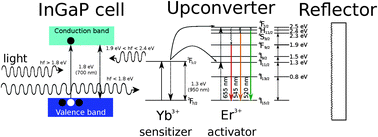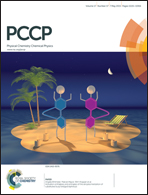Er3+/Yb3+ upconverters for InGaP solar cells under concentrated broadband illumination
Abstract
The inability of solar cell materials to convert all incident photon energy into electrical current, provides a fundamental limit to the solar cell efficiency; the so called Shockley–Queisser (SQ) limit. A process termed upconversion provides a pathway to convert otherwise unabsorbed low energy photons passing through the solar cell into higher energy photons, which subsequently can be redirected back to the solar cell. The combination of a semi-transparent InGaP solar cell with lanthanide upconverters, consisting of ytterbium and erbium ions doped in three different host materials (Gd2O2S, Y2O3 and NaYF4) is investigated. Using sub-band gap light of wavelength range 890 nm to 1045 nm with a total accumulated power density of 2.7 kW m−2, a distinct photocurrent was measured in the solar cell when the upconverters were applied whereas a zero current was measured without upconverter. Furthermore, a time delay between excitation and emission was observed for all upconverter systems which can be explained by energy transfer upconversion. Also, a quadratic dependence on the illumination intensity was observed for the NaYF4 and Y2O3 host material upconverters. The Gd2O2S host material upconverter deviated from the quadratic illumination intensity dependence towards linear behaviour, which can be attributed to saturation effects occurring at higher illumination power densities.


 Please wait while we load your content...
Please wait while we load your content...